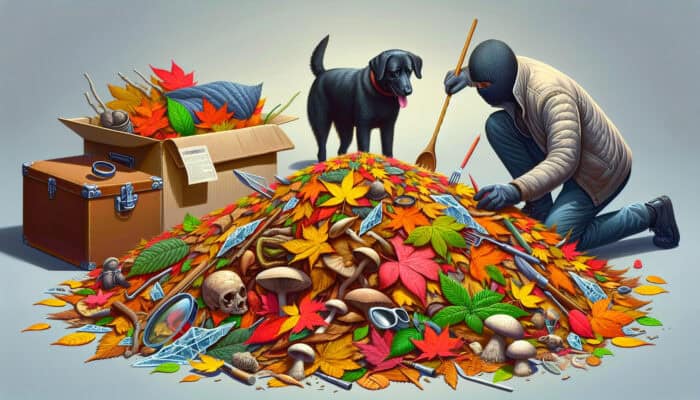Essential Safety Strategies for Enjoying Leaf Piles with Your Pets
Identifying Concealed Hazards in Leaf Piles for Pet Safety

Prior to letting your pets dive into leaf piles, it is imperative to conduct a thorough inspection to uncover any hidden dangers that could jeopardize their safety. Leaf piles often seem inviting and fun, yet they can also conceal sharp objects, hazardous insects, and toxic plants that pose serious risks to your pet’s health and well-being. Maintain a vigilant approach, as leaves can effortlessly obscure threats. Make sure to familiarize yourself with this comprehensive list of common hazards to stay alert:
- Sharp sticks or branches that can cause painful injuries
- Broken glass or metal shards that may lead to cuts and harm
- Harmful insects, including ticks and wasps, which can bite or sting
- Toxic plants, such as various types of mushrooms that are poisonous
- Plastic debris or litter that could pose choking hazards
- Rodent nests or droppings that may carry dangerous diseases
- Stagnant water that can harbor harmful bacteria and parasites
- Unknown plant species that may cause skin irritations or allergic reactions
Having a keen eye for these potential dangers can significantly reduce the risk of accidents, ensuring that your pets have a delightful and safe experience while frolicking in the leaves. Prioritizing safety is not only crucial; it also enhances the overall enjoyment of leaf pile adventures alongside your furry companions.
The Importance of Supervision During Leaf Pile Play for Pets
Consistent supervision of your pets while they play in leaf piles is absolutely essential for their safety and overall health. This watchful eye helps mitigate the risks associated with pets ingesting leaves or other materials that could lead to distress, digestive issues, or other health complications. By remaining attentive, you can quickly address any problems before they escalate. Here are some signs of distress that you should be vigilant about:
- Excessive scratching or biting at their skin
- Vomiting or indications of nausea
- Behavior changes, including increased lethargy or anxiety
- Drooling or excessive panting that seems unusual
- Breathing difficulties or coughing fits
- Refusing to play or engage with their surroundings
- Signs of pain, such as whining or whimpering
- Unusual swelling or redness on their body
Recognizing these signs early on empowers you to take prompt action, safeguarding your pet’s well-being and maintaining a safe environment as they revel in their leaf pile escapades.
Establishing a Safe Play Area for Pets in Leaf Piles
Creating a designated play zone for your pets within leaf piles is vital to ensure a secure and enjoyable experience for them. A safe play environment must be free from hazards and spacious enough to allow pets to explore freely without feeling restricted. Ideally, this play zone should be no smaller than 10 feet by 10 feet, providing ample room for pets to romp and play energetically without the risk of feeling cramped. This size facilitates unrestricted movement, ensuring pets can engage in their playful activities while minimizing the chances of collisions or falls.
Moreover, it’s important to establish clear boundaries around the play area to prevent pets from wandering into unsafe zones. Using barriers, natural features like trees, or fencing can help create a defined and secure space where pets can enjoy their time in the leaves without any concerns for their safety.
Critical Health Considerations for Pets Playing in Leaf Piles

Identifying Allergic Reactions to Leaves in Pets
Pets can sometimes experience allergic reactions to certain types of leaves, leading to skin irritations or respiratory problems. Recognizing these allergies is crucial to ensuring your pet’s comfort during their leaf pile playtime. Common signs of an allergy may include sneezing, excessive scratching, or the appearance of a rash on their skin. Pet owners should closely observe their pets following playtime in leaf piles to quickly identify any adverse reactions that may arise.
If you suspect that your pet may have an allergy to leaves, consulting a veterinarian is essential for personalized guidance and potential allergy testing. Understanding your pet’s sensitivities empowers you to choose the right types of leaves for play, prioritizing their health and safety in outdoor environments.
Identifying Ingestion Hazards and Prevention Tactics
The risk of pets ingesting leaves can lead to serious health problems, including digestive issues that may require veterinary intervention. To reduce these risks, pet owners should closely monitor their animals during playtime. Signs that indicate leaf ingestion in pets may include vomiting, diarrhea, excessive drooling, or signs of lethargy.
Effective prevention strategies involve training pets to refrain from consuming leaves and redirecting their attention to safer alternatives, including toys or treats. Providing a variety of pet-safe options can help maintain their focus away from leaves, ensuring a worry-free play experience for both pets and their owners.
The Importance of Regular Veterinary Check-Ups for Pets

Regular veterinary visits are fundamental for maintaining your pets’ health, especially after engaging in vigorous activities in leaf piles. These check-ups are crucial for detecting any potential health concerns that may develop due to exposure to leaves or environmental changes.
Evaluating pets after they play in the leaves can help identify irritations, infections, or parasitic infestations that may occur as a result of leaf exposure. Cultivating a strong relationship with your veterinarian allows for timely interventions and personalized health strategies, contributing to your pet’s optimal health and longevity.
Mitigating Parasite Risks Linked to Leaf Play
Leaf piles can inadvertently become breeding grounds for parasites like ticks and fleas, posing significant health risks for pets. To protect against parasite exposure, it is vital to conduct regular inspections and implement preventive measures. Daily checks for ticks, particularly in areas known for infestations, can substantially reduce the chances of your pets contracting these pests.
Utilizing veterinarian-recommended flea and tick prevention methods is essential for safeguarding your pets. Additionally, maintaining a clean leaf pile environment helps decrease the likelihood of parasite habitation, ensuring that your pet’s outdoor play remains both enjoyable and safe.
Seasonal Health Precautions for Pets Engaging in Leaf Play
The autumn season introduces unique challenges for pet health during leaf pile play, including the potential for mold growth on decomposing leaves. Mold can lead to respiratory issues and other health complications in pets. To protect your pet’s health while they enjoy leaf piles, ensure that the leaves are fresh and free from signs of decay.
Stay vigilant about weather conditions; damp and humid days can encourage mold growth. Regularly raking and refreshing leaf piles keeps them safe and enjoyable for pets, enabling exploration and play without health concerns.
Proven Tips for Ensuring Pet Safety During Leaf Pile Play
Real-Life Cases of Safe Practices in Leaf Pile Play
Veterinarians and pet trainers emphasize the importance of implementing safety measures when allowing pets to enjoy leaf piles. A notable case involves a dog trainer who observed a Golden Retriever having a great time in a leaf pile, while its owner diligently monitored for potential hazards. This responsible approach not only ensured the dog’s safety but also illustrated the immense joy that leaf pile play can bring to pets.
Experts suggest that certain types of leaves are safer for play. For instance, maple leaves are less likely to irritate a pet’s skin compared to other species. Pet owners must be well-informed about which leaves are safe for their pets to enjoy without compromising their health.
Practical Steps to Enhance Pet Safety During Leaf Play
To ensure that pets can enjoy leaf piles safely, experts recommend adopting practical measures that every pet owner should consider. First, always conduct a thorough inspection of the play area to eliminate any potential hazards. Second, create a designated play zone where pets can roam freely without restrictions.
Third, maintain close supervision of pets during play, looking out for any signs of distress or potential issues. Lastly, encourage the use of safe toys and treats to enhance the experience while minimizing the risks associated with ingesting leaves and debris. By implementing these strategies, you can establish a safer environment for pets as they embark on their playful adventures in leaf piles.
Expert Perspectives on Leaf Pile Hazards
Professionals highlight the significance of recognizing the potential dangers that may arise during leaf pile play. Common risks include sharp objects hidden within the leaves and the possibility of ingesting decaying matter or mold. Being prepared for emergencies is crucial; having a pet first aid kit readily available can make a significant difference in critical situations.
Additionally, it’s wise to familiarize yourself with local emergency veterinary services, ensuring you know where to seek help if anything goes wrong. This knowledge brings peace of mind, allowing both pets and their owners to enjoy leaf pile play without fear of unexpected dangers.
The Essential Role of Supervision in Leaf Pile Play
Experts strongly emphasize that continuous supervision is vital during leaf pile play, ensuring that pets remain safe while fully enjoying their outdoor experiences. By staying close, owners can promptly intervene if their pets show signs of distress or engage in risky behaviors, such as consuming leaves. This vigilant supervision not only protects pets but also enhances the bonding experience between pets and their owners.
Engaging with pets during their playtime fosters trust and understanding, enriching the experience for both parties involved. Always remember that a watchful eye leads to safe and joyful play for your furry companions.
Maximizing Enjoyment and Safety in Leaf Pile Play for Pets
Enhancing Playtime with Engaging Toys and Treats
Incorporating pet-safe toys and treats into leaf piles can significantly elevate the play experience, encouraging engagement and enjoyment. Selecting durable toys specifically designed for outdoor use is essential. Options such as rubber balls, tug ropes, and plush toys are excellent choices that can withstand vigorous play while keeping pets entertained and stimulated.
Additionally, scattering treats throughout the leaf pile can activate their sense of smell and create an exciting treasure hunt atmosphere, making playtime even more thrilling. Selecting treats that are easy to digest ensures they contribute positively to the experience without posing any health risks to your pet.
Organizing Themed Play Sessions for Maximum Engagement
Creating themed play sessions is a creative way to maintain pet engagement and safety during leaf pile activities. Themes can revolve around seasonal festivities, encouraging pets to interact with various scents and colors found in the leaves. For instance, a Halloween-themed session could involve playing with orange and black toys amidst the colorful autumn leaves.
Incorporating music or decorations related to the theme can make playtime more immersive and enjoyable for both pets and their owners. This imaginative approach not only enhances the fun factor but also reinforces the importance of safety in a captivating way.
Monitoring Play Duration for Optimal Pet Safety
Limiting play sessions to a reasonable duration is crucial for preventing overexertion and ensuring pets remain safe while enjoying leaf piles. Typically, the ideal length for leaf pile play sessions should be around 15 to 20 minutes, although this may vary based on the pet’s breed and energy levels.
Encouraging frequent breaks during play allows pets to hydrate and rest, especially on warmer days. Observing their enthusiasm and energy levels can help determine when to conclude a session, ensuring that pets relish their time without unnecessary fatigue or stress.
Understanding the Environmental Impact of Leaf Pile Play
The Benefits of Selecting Biodegradable Leaves
Choosing safe and biodegradable leaves is vital for minimizing the environmental impact of leaf pile play. Using leaves from non-toxic trees, such as maples or oaks, is not only safe for pets but also aligns with eco-friendly practices. This mindful approach reduces waste and promotes a sustainable environment while allowing pets to enjoy natural play areas.
Pet owners should take proactive steps to ensure that the leaves selected for play are free from harmful pesticides or chemicals, further enhancing the safety of the environment in which their pets frolic.
Maintaining Leaf Piles for Cleanliness and Safety
Regular upkeep of leaf piles is essential to keep them clean and safe for pets. Raking and refreshing leaf piles every few days, especially during peak autumn, helps ensure they remain inviting and free from decay.
This ongoing maintenance prevents the buildup of mold and bacteria, which could pose health risks for pets. Furthermore, routinely cleaning the piles encourages pets to engage with fresh, vibrant leaves, enhancing their overall playtime experience.
Practicing Responsible Leaf Disposal Methods
Proper disposal of leaf piles is crucial for preventing environmental harm and ensuring pet safety. Composting leaves is an excellent practice, enriching the soil while minimizing waste. For those unable to compost, adhering to local disposal guidelines ensures safe and responsible handling of organic waste.
Furthermore, ensuring that leaf piles are disposed of away from pet play areas helps prevent potential hazards associated with decaying materials. This diligent care demonstrates a commitment to both pet safety and environmental responsibility within your community.
Exploring the Advantages of Leaf Pile Play for Pets
Boosting Physical Fitness and Exercise Through Leaf Play
Leaf pile play offers an exceptional opportunity for pets to engage in physical exercise and maintain their fitness levels. Activities such as running, jumping, and burrowing through piles of leaves help pets burn off excess energy while enjoying the great outdoors. The varied terrain of leaf piles also aids in muscle development and promotes cardiovascular health, positively influencing their overall well-being.
Additionally, the excitement of exploring a new environment keeps pets active and encourages them to adopt healthy behaviors. This interaction fosters a well-rounded lifestyle, which is essential for a pet’s long-term health and vitality.
Providing Mental Stimulation and Enrichment Through Play
Engaging with leaf piles delivers crucial mental stimulation and enriching experiences for pets. The diverse textures, smells, and sounds associated with leaves ignite their senses, fostering cognitive development and mental agility.
Offering opportunities for pets to explore and interact with their surroundings nurtures curiosity and encourages problem-solving skills. This sensory engagement is vital for their mental well-being, making leaf pile play a significant aspect of a balanced pet care regimen.
Strengthening Connections and Social Interaction with Pets
Leaf pile play can significantly fortify the bond between pets and their owners while facilitating social interactions with other pets. Engaging in outdoor play reinforces relationships, nurturing love and trust between pets and their humans.
Moreover, when pets play together in leaf piles, they learn to socialize and develop important communication skills. This interaction not only contributes to their emotional health but also makes them more adaptable in various environments and social situations.
Encouraging Sensory Exploration and Development
Leaf pile play enables pets to engage their senses, promoting sensory development and exploration of their surroundings. The crunching sound of leaves, the varying textures, and the distinct smells create a multi-sensory experience that captivates pets and stimulates their instincts.
This exploration ignites their curiosity, encouraging them to discover new aspects of their environment. Sensory play is a crucial component of a pet’s overall development and aids them in adapting more effectively to changes in their surroundings.
Effective Strategies for Ensuring Pet Safety During Leaf Pile Play
Real-Life Examples of Successful Pet Safety Measures
Pet care professionals illustrate effective strategies for ensuring pet safety during leaf pile play. One noteworthy example involves a veterinarian who advocates for a pre-play inspection routine, checking for hazards in the area before playtime begins. This proactive measure can prevent accidents and establish a secure environment for pets.
Moreover, pet trainers often share techniques to redirect pets’ focus from dangerous materials, ensuring they engage safely with leaf piles. These real-world examples reinforce the necessity of preparation and vigilance in keeping pets safe as they enjoy their outdoor adventures.
Actionable Steps to Create Safe Play Areas
Experts recommend adhering to detailed guidelines to design and maintain safe play areas featuring leaf piles. First, select a suitable location far from roadways and heavy foot traffic. Next, clear the area of any potential hazards, ensuring that sharp objects or toxic plants are removed.
Establish a designated boundary to keep pets within the secure play zone, using natural features or temporary fencing. Lastly, maintain regular inspections of the play area to keep it clean and safe, allowing pets to enjoy their time without worry or concern.
Expert Insights on Pet Behavior During Leaf Play
Understanding pet behavior during leaf pile play can greatly enhance safety. Behaviorists emphasize the importance of recognizing how pets interact with their environment, including their tendencies to dig or chew on objects.
By observing these behaviors, owners can take proactive measures to redirect pets’ actions away from potentially harmful materials. This understanding deepens the bond between pets and owners, ensuring a safe and enjoyable playtime experience for everyone involved.
How Can Pet Owners Educate Themselves on Leaf Pile Safety?
Utilizing Online Resources for Pet Safety Education
Leveraging a variety of online resources can significantly enhance pet owners’ understanding of leaf pile play safety. Websites dedicated to pet care often provide comprehensive guides, tips, and safety checklists designed to educate owners on potential hazards and best practices for keeping pets safe.
Following veterinarians, trainers, and pet safety advocates on social media platforms is another excellent way to stay informed. Engaging with these resources allows pet owners to connect with experts and gather valuable insights on keeping their pets safe during outdoor play.
Participating in Workshops and Seminars on Pet Safety
Joining workshops and seminars that focus on pet safety during outdoor activities, including leaf pile play, can significantly improve pet owners’ knowledge. These events typically feature expert speakers who share valuable insights and practical strategies for ensuring pet safety and well-being.
Networking with fellow pet owners during these sessions fosters a sense of community, allowing for support and the sharing of experiences regarding effective safety measures. This collective knowledge enables owners to make informed decisions about their pets’ activities and safety.
Consulting with Veterinarians for Tailored Advice
Regular consultations with veterinarians can provide personalized advice on leaf pile play safety for pets. Pet owners should inquire about specific concerns, such as potential allergies or parasite exposure related to outdoor play.
Veterinarians can recommend preventative care measures to ensure pets remain healthy and safe. Open communication with vets helps pet owners develop a holistic approach to pet care, encompassing both safety and enjoyment during playtime.
Exploring Books and Guides on Pet Safety
Diving into books and guides dedicated to pet safety offers a wealth of information, including specific chapters on safe leaf pile play and associated hazards. These resources often present research-backed insights that empower pet owners to navigate safety effectively.
Investing in quality literature focused on pet care can ultimately lead to improved outcomes for pet health and safety during outdoor activities. The knowledge gained from these resources enables owners to create enriching and secure environments for their pets.
Engaging with Pet Owner Communities for Collective Wisdom
Joining online forums and local pet owner groups provides opportunities to share experiences and learn about leaf pile safety from other pet owners. Interacting with the community fosters a collaborative spirit and enhances overall knowledge regarding best practices for keeping pets safe.
These interactions not only enrich pet owners’ understanding but also create lasting friendships among like-minded individuals. Community engagement promotes a sense of shared responsibility and care for pets’ well-being during outdoor adventures.
Seasonal Considerations for Safe Leaf Pile Play
How to Adjust Play for Varying Weather Conditions
Adapting leaf pile play to accommodate different weather conditions is essential for ensuring pet safety. In wet weather, leaves can become slippery, increasing the risk of falls and injuries. To adjust, consider limiting playtime or relocating to a more stable area where pets can safely engage without the risk of slipping.
During colder weather, ensure pets are adequately protected from harsh elements. Monitoring temperature and wind conditions helps determine whether outdoor play is suitable. Understanding these adjustments allows pet owners to maximize enjoyment while keeping their pets safe during leaf pile play, regardless of the weather conditions.
Selecting Optimal Times for Leaf Play Sessions
Choosing the right times of day for leaf pile play ensures pets are safe and comfortable. Generally, mornings and late afternoons offer ideal temperatures, avoiding the midday heat that can lead to overheating or exhaustion in pets.
Additionally, during cooler months, ensuring that playtime occurs when the sun is shining can help keep pets warm and comfortable. Being mindful of timing helps maximize the enjoyment and safety of leaf pile play for your furry companions.
Preparing for Seasonal Changes in Leaf Play
Adapting leaf pile play strategies to accommodate seasonal changes is critical for maintaining ongoing safety for pets. As autumn progresses, be prepared to adjust play areas and techniques based on various leaf types and conditions.
Using fresh, vibrant leaves while avoiding moldy or decaying materials is crucial as the seasons change. Establishing a routine for inspecting play areas throughout the fall ensures pets remain safe and healthy while they enjoy the beauty of autumn leaves.
Frequently Asked Questions About Leaf Pile Safety
What hazards should I look for in leaf piles?
Common hazards include sharp objects, harmful insects, toxic plants, and decaying matter that may pose health risks for pets.
How can I determine if my pet is allergic to leaves?
Signs may include excessive scratching, sneezing, or skin irritations. Consulting a veterinarian for testing can provide definitive answers regarding allergies.
What steps should I take if my pet ingests leaves?
Monitor for signs of distress such as vomiting or lethargy. If symptoms persist, consult your veterinarian for guidance and appropriate action.
Why are regular health check-ups important after leaf play?
Regular check-ups help identify any potential health issues arising from exposure to leaves, ensuring timely intervention and overall well-being for your pets.
What methods can I use to protect my pets from parasites in leaf piles?
Employing veterinarian-recommended flea and tick prevention strategies and regularly checking for parasites can help safeguard pets during leaf pile play.
Which types of leaves are safe for pets to play in?
Leaves from non-toxic trees like maples and oaks are generally safe. Always ensure they are free from harmful pesticides and chemicals before permitting pets to play.
What is the ideal duration for leaf pile play sessions?
Aim for sessions lasting approximately 15 to 20 minutes, allowing pets to enjoy themselves without risking overexertion or fatigue.
Should I include toys in leaf pile play?
Yes! Adding durable, pet-safe toys can enhance engagement and encourage active play while minimizing the risks associated with ingesting leaves and debris.
What can I do to ensure my pet’s safety during play?
Supervise closely, create a safe environment, and remain aware of your pet’s behavior for any signs of distress or ingestion of harmful materials.
How often should I maintain leaf piles for pet safety?
Regular maintenance every few days during peak leaf fall is recommended to ensure cleanliness and safety for pets engaging in play.
Connect with us on Facebook!
The Article Leaf Pile Play Precautions For Pets: Universal Safety Tips First Published On https://elgatoencasa.com
The Article Pet Safety Tips for Leaf Pile Play: Essential Precautions Was Found On https://limitsofstrategy.com

